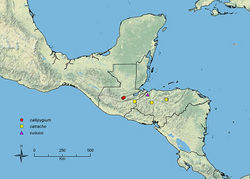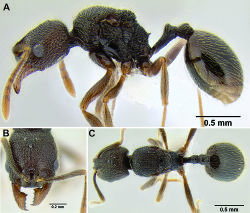Stenamma catracho
| Notice: | This page is derived from the original publication listed below, whose author(s) should always be credited. Further contributors may edit and improve the content of this page and, consequently, need to be credited as well (see page history). Any assessment of factual correctness requires a careful review of the original article as well as of subsequent contributions.
If you are uncertain whether your planned contribution is correct or not, we suggest that you use the associated discussion page instead of editing the page directly. This page should be cited as follows (rationale):
Citation formats to copy and paste
BibTeX: @article{Branstetter2013ZooKeys295, RIS/ Endnote: TY - JOUR Wikipedia/ Citizendium: <ref name="Branstetter2013ZooKeys295">{{Citation See also the citation download page at the journal. |
Ordo: Hymenoptera
Familia: Formicidae
Genus: Stenamma
Name
Stenamma catracho Branstetter, 2013 sp. n. – Wikispecies link – ZooBank link – Pensoft Profile
Type material
Holotype worker. HONDURAS: Olancho, Parque Nacional La Muralla, 15.09965°N, 86.74072°W ±20m, 1530m, 2 May 2010, cloud forest, ex sifted leaf litter (LLAMA, collection Wa-C-01-1-36) [USNM, specimen CASENT0621306]. Paratypes: same data as holotype [1dq, 1w, USNM, CASENT0621305, CASENT0621307], [1w, CAS, CASENT0621308]; same data as holotype but 15.09925°N, 86.74063°W ±20m, 1530m, 2 May 2010 (LLAMA, Wa-C-01-1-27) [1w, EAPZ, CASENT0621298], [1w, ECOSCE, CASENT0621299], [1w, FMNH, CASENT0621297], [1w, ICN, CASENT0621300]; 15.09859°N, 86.74216°W ±10m, 1510m, 2 May 2010 (LLAMA, Wm-C-01-1-03) [1w, INBio, CASENT0622022], [1w, JTLC, CASENT0622023], [1w, LACM, CASENT0622024], [1w, MGBPC, CASENT0623530], [1w, MCZ, CASENT0623531], [1w, MZSP, CASENT0623532], [1w, UCD, CASENT0623533]; 15.09694°N, 86.74533°W ±10m, 1460m, 5 May 2010 (LLAMA, Wm-C-01-1-09) [1w, UNAM, CASENT0622048], [1w, UVGC, CASENT0623534].
Worker diagnosis
Integument mostly dark red-brown to orange-brown; small-sized species (see HL, ML, PrW below); anterior clypeal margin viewed from anterodorsal angle undulating (straight in full-face view), appearing as 2–4 blunt teeth; basal margin of mandible sinuous, with a shallow, but distinct basal depression; head and mesosoma densely sculptured, mostly rugoreticulae; gastral pilosity short, relatively dense, and usually appearing uniformly suberect to subdecumbent, but sometimes more clearly bilayered; petiole somewhat long and gracile, with node relatively small; petiolar and postpetiolar nodes smooth only on anterior faces; eye relatively small (EL 0.08–0.09, REL 14–16), subcircular to oval-shaped, with 4–5 ommatidia in greatest diameter; frontal lobes moderately expanded (FLD 0.15–0.18, FLI 28–33), mostly to completely covering torular lobes in full-face view; propodeal spines short to medium length (PSL 0.11–0.18, PSI 1.6–2.1). Similar species: Stenamma crypticum, Stenamma cusuco, Stenamma hojarasca.
Geographic range
Guatemala to Honduras.
Description
Worker description.
(9 measured) HL 0.61–0.68 (0.68), HW 0.51–0.59 (0.58), FLD 0.15–0.18 (0.18), PCW 0.01–0.03 (0.03), SL 0.52–0.55 (0.55), EL 0.08–0.09 (0.08), ACL 0.51–0.54 (0.53), ML 0.75–0.82 (0.82), PrW 0.36–0.41 (0.41), PSL 0.11–0.12 (0.12), SDL 0.05–0.07 (0.07), PL 0.28–0.32 (0.32), PH 0.15–0.17 (0.17), PW 0.12–0.13 (0.13) PPL 0.13–0.15 (0.15), PPH 0.13–0.15 (0.15), PPW 0.15–0.16 (0.16), MFL 0.57–0.63 (0.62), MTL 0.47–0.51 (0.51), CI 82–88 (86), SI 92–104 (94), REL 14–16 (14), FLI 28–33 (32), PSI 1.6–2.1 (1.8); MFI 84–95 (93), ACI1 68–71 (68), ACI2 96–102 (96).
Small species; general body color dark red-brown to orange-brown, with patches of dark brown to brown on gaster; appendages lighter, brown to yellow-brown; setae golden brown; mandible with 6 teeth, consisting of 3 distinct apical teeth, a basal tooth, and 2 middle teeth, which are often worn and indistinct; basal margin of mandible sinuous, with a shallow, but distinct basal depression, accompanied by attenuation of cuticle where mandible fits underneath clypeus; mandible mostly smooth and shining, with scattered piligerous punctae and basal striae; anterior clypeal margin viewed at anterodorsal angle undulating (straight in full-face view), appearing as 2–4 blunt teeth; median lobe of clypeus somewhat flattened, longitudinal carinulae absent or very faint, apex with a short transverse carinula; remainder of clypeus mostly smooth and shiny; posterior extension of clypeus between antennal insertions narrow (PCW 0.01–0.03), sides diverging posteriad; frontal lobes moderately expanded (FLD 0.15–0.18, FLI 28–33), with lateral apices shifted slightly posteriad of torular lobes, which are mostly to completely covered in full-face view; head subrectangular to oval-shaped (CI 82–88), posterior margin slightly depressed medially; eye relatively small (EL 0.08–0.09, REL 14–16), subcircular to oval-shaped, with 4–5 ommatidia in greatest diameter; head mostly rugoreticulate, with a few longitudinal rugae along midline, interstices faintly punctate; scape relatively long (SI 94–104), but variable, either reaching or not quite reaching posterior margin when laid back; scape surface shiny, but somewhat rough, with punctae and faint striae; flagellum with distinct 4-segmented antennal club; mesosoma densely sculptured, except for propodeal declivity, which only has a few faint transverse carinulae; promesonotal dorsum rugose to rugoreticulae, interstices faintly punctate; mesosomal side mostly punctate, with a few rugulae; propodeal dorsum with a few transverse carinae; promesonotum in profile, low-domed, roughly symmetrical; metantoal groove distinct, but somewhat shallow; anterodorsal margin of propodeum in profile with a small welt; propodeal spines present, short to medium length (PSL 0.11–0.18, PSI 1.6–2.1); petiole somewhat long and gracile (PL/HW 0.53–0.59); petiolar node in profile relatively small (PH/PL 0.49–0.59), asymmetrical, with anterior face long and sloping and posterior face short and nearly vertical, dorsum of node rounded, apex pointing posteriad; postpetiole relatively small (PPH/PH 0.85–0.91), somewhat dorsoventrally compressed; anterior faces of petiolar and postpetiolar nodes smooth and shiny, remainder of waist mostly punctate, with a few small rugulae around postpetiolar node; gaster mostly smooth and shiny, with scattered piligerous punctae; most of body dorsum with short to moderately long standing pilosity; scape with suberect to decumbent setae; gastral pilosity variable, usually short, relatively dense, and uniformly suberect to subdecumbent, but sometimes clearly bilayered, with a longer suberect layer, and a shorter decumbent layer; setae on legs mostly decumbent to appressed, with some suberect setae on coxae and venter of profemur. Queen description.
(3 measured) HL 0.67–0.69 (0.69), HW 0.59–0.62 (0.61), FLD 0.16–0.21 (0.21), PCW 0.02–0.04 (0.02), SL 0.56–0.58 (0.56), EL 0.16–0.18 (0.17), ACL 0.54–0.57 (054), ML 0.92–1.00 (0.95), PrW 0.50–0.55 (0.53), PSL 0.15–0.16 (0.15), SDL 0.08–0.09 (0.09), PL 0.36–0.38 (0.38), PH 0.18–0.20 (0.19), PW 0.15–0.16 (0.15), PPL 0.15–0.17 (0.15), PPH 0.18–0.19 (0.18), PPW 0.19–0.20 (0.19), MFL 0.63–0.69 (0.63), MTL 0.53–0.58 (0.53), CI 88–90 (88), SI 92–96 (92), REL 27–30 (27), FLI 25–34 (34), PSI 1.6–2.1 (1.6), MFI 88–97 (97), ACI1 67–69 (69), ACI2 96–98 (69).
Same as worker except for standard queen modifications and as follows: mesoscutum mostly longitudinally rugose, but with a central longitudinal carina that is thick at anterior margin; most of katepisternum and part of anepisternum smooth and shiny; gastral pilosity denser, and more distinctly bilayered. Male.
Unknown.
Biology
Stenamma catracho is known only from sifted leaf litter collected from the forest floor. It occurs from approximately 1100–1900 m elevation in montane wet forest habitats.
Comments
Stenamma catracho is most likely to be confused with Stenamma cusuco or Stenamma hojarasca, both of which have expanded frontal lobes and somewhat elongate petioles. Stenamma cusuco can be distinguished easily by its distinctive tridentate clypeal margin, and Stenamma hojarasca can be separated by its longer petiole and completely shiny petiolar and postpetiolar nodes.
There are some morphological differences unique to the Meambar population (Figure 62) of Stenamma catracho. Meambar specimens have most pilosity longer, with the gastral pilosity clearly bilayered; they have lighter integument color; and they have narrower frontal lobes. The other populations have the pilosity shorter overall and the gastral pilosity denser and not as clearly bilayered. I treat these differences as intraspecific variation until more material is collected.
Molecular phylogenetic data show that Stenamma catracho most likely belongs to a clade that includes Stenamma crypticum, Stenamma monstrosum, and Stenamma saenzae, with Stenamma monstrosum being its sister species (Branstetter unpublished data).
Material examined
GUATEMALA: Zacapa : 2km SE La Unión, 14.95344°N, 89.27587°W, 1430m, 12 May 2009 (LLAMA); HONDURAS: Comayagua : PN Cerro Azul Meambar, 14.86960°N, 87.89843°W, 1140m, 20 May 2010 (LLAMA); Olancho : PN La Muralla, 15.09511°N, 86.73925°W, 1420m, 2 May 2010 (LLAMA); PN La Muralla, 15.09965°N, 86.74072°W, 1530m, 2 May 2010 (LLAMA); PN La Muralla, 15.10257°N, 86.73642°W, 1650m, 2 May 2010 (R. S. Anderson); PN La Muralla, 15.09807°N, 86.72047°W, 1860m, 3 May 2010 (LLAMA).
Original Description
- Branstetter, M; 2013: Revision of the Middle American clade of the ant genus Stenamma Westwood (Hymenoptera, Formicidae, Myrmicinae) ZooKeys, 295: 1-277. doi
Images
|



